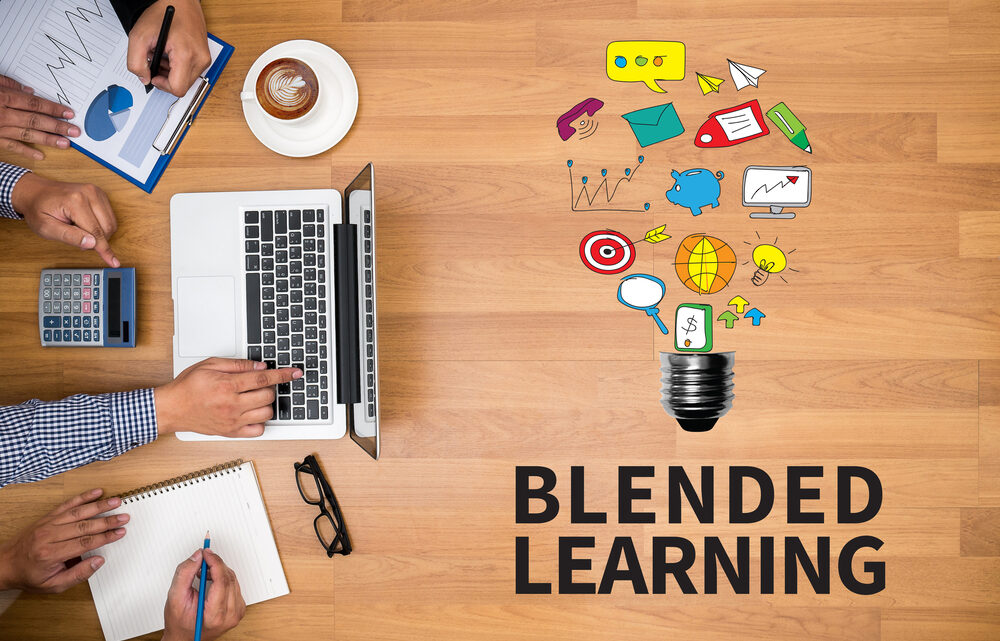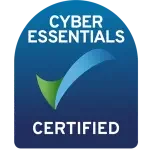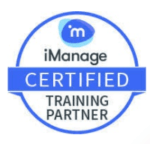
The concept of blended learning is a teaching method that combines online and face-to-face education. It’s not just a cool buzzword you hear thrown around. It’s an effective way to deliver education, especially when it comes to professional development areas like leadership training, business skills development, and computer training.
In this article, we’ll take a look at how this kind of learning works, why it’s effective, and how you can use blended learning strategies in your workplace to get a headstart with your eLearning.
IN THIS ARTICLE...
What is Blended Learning in the Workplace?
Blended Learning (often called Hybrid Learning) is a form of education that combines face-to-face teaching with online content. This approach to delivering online and offline learning is becoming increasingly popular as it has many benefits over traditional classroom teaching.
Learning in this way requires the use of learning tools such as a learning management system. This will enable you to manage both the online courses and instructor-led events.
A recent study by McKinsey found that 90% of faculty members in higher education believed that learning tools were worth the time and effort to deploy them, particularly in the areas of connectivity and community building.
The key advantage of learning in this way is that it enhances learner engagement and supports knowledge retention by combining different methods of instruction. This kind of learning can be used for both formal and informal educational programs at any age level.
It also helps individuals who are not able to attend regular classes because they are working or have other responsibilities outside of their education program.
What are the advantages of Blended Learning?
Blended or hybrid learning is a combination of traditional and non-traditional learning methods. It’s an approach that blends face-to-face instruction with self-paced or computerized learning, allowing students to learn at their own pace while still receiving guidance from instructors and peers.
A learning system like this has many benefits for both the organization and the employee:
- Allows learners to choose appropriate training based on their needs and learning styles
- Provides flexibility with classroom schedules
- Makes it easier for employees to learn on the go
- Allows employees to learn at their own pace
- Increases the effectiveness of training by allowing employees to practice what they’ve learned
- Reduces training costs by reducing the need for instructors and facilities Allows employees to learn from each other
Blended learning programs can also be an effective way to get the most out of your training budget. Here are some of the benefits:
- Cost savings over traditional training methods – our clients save an average of $18,000 in training costs per new hire
- Improved employee engagement through personalized learning paths
- Increased productivity from skills transferred back to the workplace
- A faster return on investment (ROI) than with other forms of training
If you’re looking for ways to improve your workforce’s skills, then consider using these blended learning guidelines in your next training initiative.
What are the Four Blended Learning Models?
Blended learning models combine online and in-person training. Learners can complete activities on their own schedule, allowing them more control over their learning process.
The blended learning approach to training isn’t a one-size-fits-all solution and lends itself to offering variety. The Clayton Christensen Institute for Disruptive Innovation has outlined the 4 most common types of blended learning methods.
1. Blended Learning Flex Model
Flex Model combines traditional face-to-face instruction with online learning activities. It allows learners to move back and forth between physical classroom training and digital learning, depending on their needs. This model blends online learning with in-person instruction in an alternating fashion, allowing learners to work independently at home and attend classes when necessary.
This approach is well suited for self-directed learners who are comfortable working in an online environment and have the necessary technological skills.
2. Rotation Model
In the Rotational Model, learners rotate through different learning environments such as small group instruction, independent learning stations, online learning tasks, and teacher-led activities. In this model, students are divided into smaller groups that rotate between online and in-person instruction. Each group receives different content or activities during the rotations, giving them individualized instruction based on their learning needs.
This approach allows instructors to focus on individual needs and gives learners access to various educational experiences throughout the course.
This model can be broken down further into Flipped Classroom, Station Rotation, Lab Rotation, and Individual Rotation. More information about the models and sub-models can be found at BLU.
3. À La Carte Model Blended Learning
À La Carte Model allows learners to customize their learning experience by selecting from a range of topics and activities from both online and face-to-face settings. The activities are usually divided into individual courses completed at the learner’s own pace.
This blended learning model offers learners a selection of digital tools and activities to choose from for their own learning process. This allows for personalization and self-paced instruction for learners of all ages and abilities.
4. Enriched Virtual Model
In the Enriched Virtual Model, virtual classroom technologies such as video conferencing or chat rooms are used to supplement existing instructional materials such as textbooks or other web resources. This model is designed to bring real-world learning experiences into the virtual classroom by incorporating virtual simulations, virtual field trips, webinars, and video conferencing, along with traditional online teaching methods.
Learners interact with their peers, instructors, and learning materials in a collaborative blended learning environment, while also engaging in more self-paced online activities when appropriate.
What is a Flipped Classroom?
Included under the Rotation Model of approaches to blended learning, a Flipped Classroom Model is most commonly used in schooling and switches up the traditional relationship between time in class and homework. Students learn at home via online courses, modules, and lectures. The teachers in a flipped classroom use class time for guided practice or practical projects.
Synchronous vs Asynchronous Learning
The debate over synchronous vs asynchronous learning is not a new topic, but it has received renewed attention in the last decade or so. On one hand, synchronous learning can give students opportunities to learn with and from each other in ways that asynchronous learning does not.
On the other hand, synchronous learning can be a stressful experience for some students who are not comfortable speaking in front of an audience or being called upon unexpectedly. Ultimately it is up to instructors to decide how much of a role synchronous vs asynchronous learning will play in their courses and whether or not there is an advantage to either approach.
The difference between synchronous and asynchronous learning is the time delay that exists between the instructor and the student. Synchronous learning refers to a real-time interaction where both the instructor and student are actively participating in a class at the same time with no delay. This is often seen in traditional college classes or online seminars, but can also be accomplished through webinar platforms like GoToMeeting.
Conversely, asynchronous learning is when there is some form of delay between the teacher and student. The most common type of asynchronous learning is distance learning courses that use an online platform to host course content and interact with instructors and classmates.
What is a synchronous learning session?
A learning session is considered synchronous when it occurs at the same time. This means that two or more people are interacting with each other in real-time. The most common example of a synchronous learning environment is in person, but there are many online examples as well. For example, you may be watching a lecture on your computer while chatting with other students over an instant messaging tool like Skype or Google Hangouts.
In contrast to this model of communication, asynchronous communication refers to interactions that take place out of sequence from one another – for example, sending an email message or posting something on Facebook and then waiting for someone else to respond once they’ve had time to consider what was written.
What is an asynchronous learning session?
Asynchronous learning sessions are those in which the learner is not required to be present when the instruction is delivered. Asynchronous learning sessions can be conducted on demand, at any time and place. The participant may be able to pause or stop an asynchronous session until there’s time to resume it again.
Asynchronous learning sessions are ideal for employees who work outside the office and can’t attend a live training session. Asynchronous sessions also provide learners with flexibility in their schedules and allow them to learn at times when they’re most comfortable.
How can I Create Online Learning Courses?
You can create these courses and online resources in a variety of ways. You can use an LMS, an online course authoring tool, a digital content hub, or blended learning LMS solutions and digital adoption platform to deliver content. However, the choice of technology you make will depend on your budget and business goals.
Blended Learning LMS Solutions
A learning management system is an all-inclusive blended learning solution that allows you to set up and manage eLearning courses as well as track learner progress. It can also come with features like file sharing and discussion forums so that instructors and students can communicate with each other during live training sessions.
Check out this other post to get some tips about implementing a learning management system (LMS).
Teaching Techniques: Blended Learning Online Courses
An online course authoring tool is a more affordable alternative to an LMS. It allows you to create eLearning courses without being tied down by particular vendors or training companies and lets you export your content in different formats, such as SCORM, AICC, and HTML. To use this type of technology, you’ll need to know how to create courses from scratch.
A digital content hub is an online repository that lets you upload and store files. A digital adoption platform allows you to integrate your existing content into one single platform so that learners can access it whenever they want.
Pros and Cons of Blended Learning
There are many benefits of a blended learning program, but there are also disadvantages. Here are some of the pros and cons:
Pros:
- Blended learning helps you keep costs down by reducing travel expenses and eliminating the need for expensive materials or equipment.
- It helps you save time by providing students with more material in less time, which means they can finish their coursework sooner than if they were taking traditional classes alone.
- It allows students to work at their own pace because they can access lectures at any time during the day or night, on any device that has an internet connection. They don’t have to worry about missing an assignment due date if something comes up in their personal lives like illness or job loss because everything is online now!
- It encourages collaboration among employees because they’re working together toward common goals in an online environment where they can share ideas easily via email or instant messaging (which is great for companies that are located in different places across the world).
Cons:
- Learners may not have the opportunity to socialize face-to-face.
- Instructors may need to be more organized and efficient with their time.
- Students can become isolated if they’re not careful about choosing whom they interact with online.
- Setting up can require a lot of upfront investment.
This form of blended learning strategy can also help students learn more effectively by providing them with additional resources like videos, articles, and interactive activities. This allows them to go deeper into the course material than they would if they just read it in a book or if they listened to someone talk about it during a lecture.
Using Blended Learning in Your Workplace
Learning in this way is the perfect solution for companies that want to train their employees without sacrificing productivity. It allows employees to learn at their own pace, whether they’re in the office, mobile learning, or at home. Plus, because it saves on costs associated with travel, it means more money in your pocket!
We hope that this article has given you a better understanding of blended learning solutions and how they can benefit your organization. As always, the most important thing is for learners to be engaged in what they are learning. So if you’re going to implement learning like this in your workplace, make sure that it involves interaction between the instructor and students!
At Intellek, we understand how important it is to invest in your people. That’s why we support blended or hybrid learning options in our learning management system – so that you can choose what works best for your organization, based on your budget and training needs. Contact our team to see what our blended learning LMS solution can offer you.
Intellek (formerly TutorPro) is a founding member of the learning technology industry. With a presence in the USA, UK, Canada, and the EU – for over 30 years we have pioneered the development of cutting-edge eLearning software and online training solutions, with a large and diverse portfolio of international clientele.
Disclaimer: We use all the tools available including generative AI to create relevant and engaging content.






